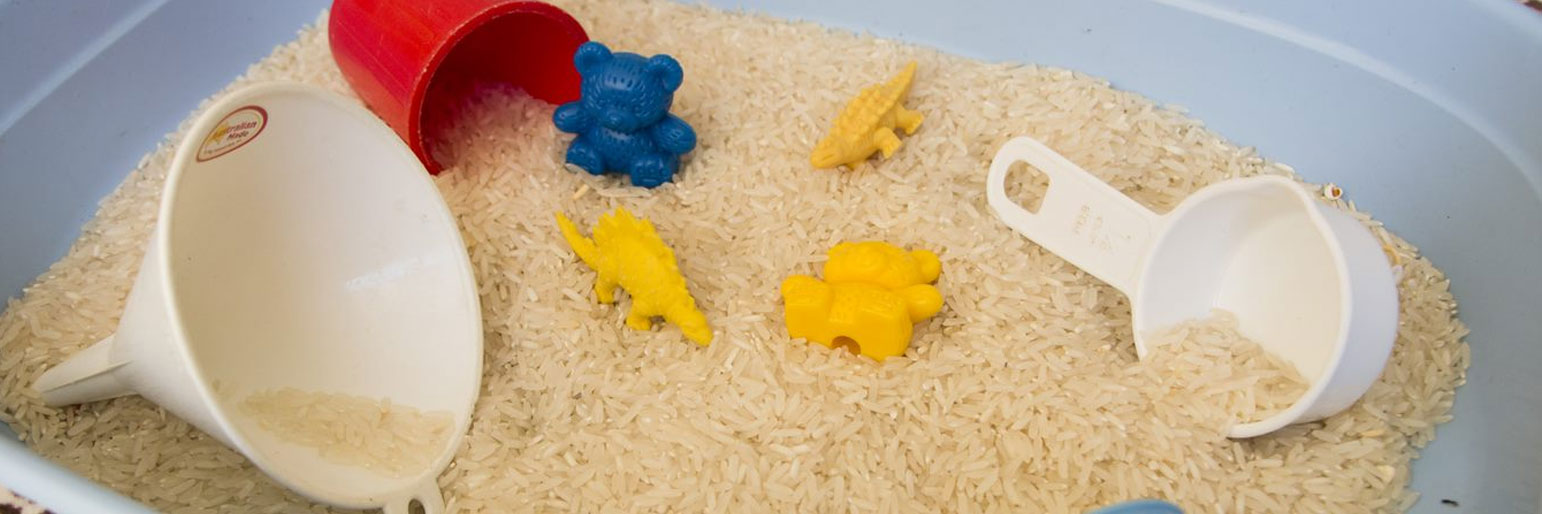Sensory tray play
Talking together
Using our senses to explore how different things look, feel, smell, taste and sound.

Activity
Sensory trays are plastic trays or tubs with different sensory activities in them. They are small enough to allow children to have their own space, and to have several at a table to allow for interactive play.
Sensory trays are great to play with each week at playgroup. You can choose what sort of sensory tray you’d like to make. See the resources section for some sensory recipes that you can use in your trays.
What you'll need
- 2–4 sensory trays (kitty litter trays work well)
- 2–4 smocks
- Tools – spoons, forks, cups etc
- A table to put the trays on or a tarp for on the ground
- Bucket of warm soapy water
- A towel for handwashing
TIP: You may like to put a wipeable tablecloth over the table to make clean-up easy.
Words to use
- Gooey, gloopy
- Wet/dry, cold/hot
- Slimy, slippery, squishy, squashy, squelchy
- Muddy, mucky, sticky, stuck, yucky
Questions to discuss
- What can you feel/smell/hear?
- What does it feel like?
Learning through play
Ways to develop numeracy through play
- Measuring – more/less, higher/lower, smaller/bigger, heavier/lighter.
- Measuring during cooking – if children help make the sensory recipes, they can see and use measuring devices such as measuring cups, spoons, scales etc.
- Fractions – when filling cups and containers, you can use fraction language, quarter, half, whole.
- Noticing change – what happens if you add more water, food, colouring, essential oils etc.
Ways to develop literacy through play
- When engaged in sensory play with an adult, children will hear (or even say) a range of descriptive words – runny, gooey, slimy, cold, soft, ooze, yucky, slippery etc.
- As children scoop, pour and manipulate the utensils, they are improving finger and hand control, and eye/hand coordination. When they use their fingers and hands in sensory play, they are building up the strength in these muscles that will help with writing later.
- Children can learn about the turn – taking involved in conversation, when adults listen, wait and respond to what the child is saying.
- Children can learn emotional language when adults respond to children’s emotions – “That makes you laugh... you feel happy when you play with that” or “Ooooh, you look unsure about touching that. It’s making you worried. That’s ok, it’s something new, we can watch together for a while.”
- Books about getting messy:
- Two Feet by Gwen Pascoe
- We’re Going on a Bear Hunt by Michael Rosen (great descriptive language)
- The Pig in the Pond by Martin Waddell.
Extensions and variations to this activity
- Variety is great for children – it keeps them interested and curious, and they may have different reactions to different sensory materials.
- Some sensory experiences to try:
- gloop*
- shaving foam
- silly spaghetti*
- rice (dry)
- beans (dry)
- cloud dough*
- finger painting
- sorbolene play
- mud play.
*Find sensory recipes in the resources section
- Any of these activities can be used on their own with kitchen tools – spoons, funnels, cups etc.
- With small world play – animals, people, dinosaurs, insects etc.
- You can make the recipes plain or add food colouring or different essences.
TIP: It’s a good idea to offer the same activity for 2 playgroup sessions to make sure all children have the opportunity to have a go. Children who were unsure the first session may have a go the second time, and repeating new skills is how children develop mastery.
Supporting parent engagement in play
Play prompts:
- Play with your child to show them that this activity is safe and fun.
- Support your child JUST ENOUGH so they can do it for themselves. Avoid the temptation to take over.
- Use describing words like gooey, wet, dry, scratchy, sloppy or slimy to talk about the activity.
- When parents/carers are alongside their children, they can help their child to feel safe, secure and curious to try something new.
- It’s important that children are given time when trying new activities, especially if they’re unsure or usually don’t like sensory/messy play.
TIP: If a child is reluctant to put their fingers in, offer them a tool to use such as a spoon, stick or cup. That way they can still be involved without feeling overwhelmed.
Parents or carers can:
- Comment on what their children are doing (say what they see).
- Talk in their home language.
- Use literacy and numeracy words (see words to use section above).
- Sit with their child.
- Have a go at the activity (model for their child).
You can help families by:
- Modelling what you want them to do.
- Talking to them about the focus of the activity and what children might be learning.
- Writing up words that go with the activity.
- Making suggestions on what families can do at home.
Related Great Start activities
Great Start activities are for parents and carers to do with their children.


